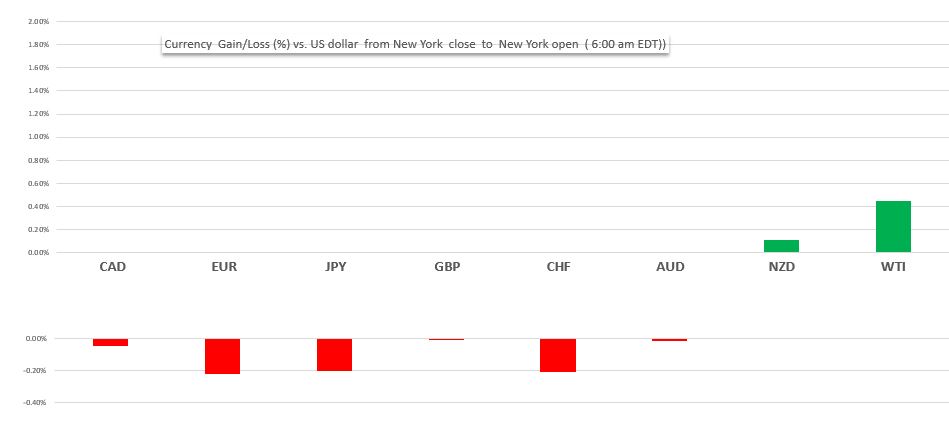
January 8, 2020
USDCAD open 1.3008-12 (6:00 am EST) Overnight Range 1.2978-1.3012
Asia markets suffered a panic attack in early, overnight trading. News that Iran fired missiles at US military bases in Iraq sent the Japanese yen, Swiss franc, gold, and oil prices soaring, while sinking US Treasury yields and Asia equity indices. The panic subsided quickly, and by the time European traders got to their desks, the focus had shifted to Eurozone economic data releases and an upcoming statement from President Trump today.
There is a dearth of data today. The US ADP employment report is due, but it will be ignored as it is a poor guide to the nonfarm payrolls result. The tone of President Trump’s statement will dictate FX direction.. If he doesn’t agree with Iran’s assessment that the missile strike was a “proportional response” to the drone attack, things will go pear-shaped in a hurry.
The US dollar opened with small gains across the board except against the New Zealand dollar, supported by the reversal of Asia price action.
FX Market Snapshot
Change in currency value against the US dollar from NY close to NY open (6:00 am EST)

Source: Saxo Bank/IFXA
EURUSD retreated from its Asia peak of 1.1167 and dropped steadily into the New York open. The selling pressure was fueled by weaker than expected German and Eurozone data. German factory orders fell 6.5% y/y in November while Eurozone Business Climate, Consumer Confidence and Industrial Climate indicators were below forecasts. The intraday technicals are bearish while prices are below 1.1180. A decisive breach of 1.1120, the December uptrend line at 1.1120 today suggests further downside to 1.1070
GBPUSD tracked higher during the Asia session and until mid-morning in Europe when it dropped from 1.3150 to 1.3094. The move coincided with the release of the Eurozone sentiment and confidence indicators. UK Prime Minister Boris Johnson meets with European Commission President Ursula von der Leyen, and Chief Brexit negotiator Michel Barnier today. GBPUSD intraday technicals are bearish with the break of the December uptrend line at 1.3110, suggesting additional losses to 1.3050.
USDJPY price action has been volatile. Early Asia losses reversed, and the technicals turned bullish with the break above the January peak of 108.70. Prices tracked 10-year US Treasury yields which dropped from 1.82% to 1.74% before rebounding to 1.80% in early New York trading.
AUDUSD and NZDUSD sank together following the Iran missile strike, Aussie lagged Kiwi in the ensuing rally, in part because the Reserve Bank of Australia appears to be more dovish than its New Zealand counterpart. The AUDUSD intraday technicals are bearish while prices are below 0.6900, but so far, support at 0.6830 has held.
WTI oil prices soared to $65.61/barrel in Asia, after closing in New York at $62.70/b. The move reversed itself as quickly as it rose. Nevertheless, the December uptrend is entrenched while prices are above $61.80/b with a break above $66.50 paving the way to $76.50/b. Prices are supported by fears the Iran/US crisis will escalate and disrupt crude shipments through the Strait of Hormuz.
Gold prices rallied steeply, touching $1,611.25/ounce, a price last seen in February,2013. Elevated Middle East tensions, concern about Trump’s reaction to the Iran retaliation, and low G-10 interest rates are supporting prices. The intraday technicals are bullish while prices are above $1,575.00.
USDCAD sank in Asia, undermined by the sharp rally in WTI oil prices, after the news of the Iran retaliation. The gains were erased when risk sentiment reversed from negative to positive, leading to broad US dollar demand. The currency pair will continue to track oil price movement and US dollar sentiment. There are reportedly good-sized option strikes at 1.3000 expiring today which should provide some support until 10:00 am. Traders are looking ahead to Thursday when Bank of Canada Governor Stephen Poloz may provide an updated monetary policy outlook. The intraday technicals are bearish below 1.3030 looking for a break of 1.2950 to accelerate losses. Today’s Range 1.2980-1.3030
Chart: USDCAD 4 hour

Source: Saxo Bank





